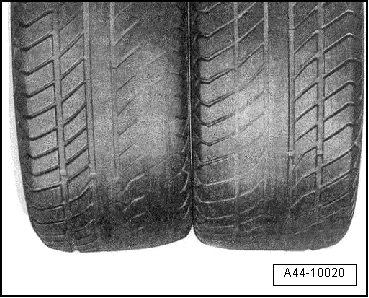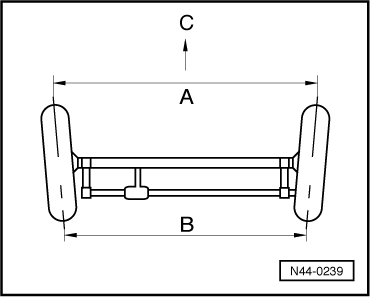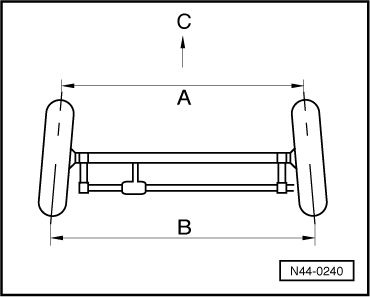Volkswagen Touran Service Manual: Tire Wear, One Sided
| In many causes, this is caused by driving style, but
sometimes it is also caused by incorrect axle adjustment. |
|
|
|
| One-sided wear, in conjunction with scrub marks on tread
ribs and finer grooves, always appears when tires roll at an
extreme slip angle and consequently "scrub"
on the road surface. |
| Driving quickly around curves leads to increased wear,
especially on the outside edge. |
| A rounded tire shoulder in conjunction with especially high
wear on the outer tread bars indicates fast driving around
curves. This wear pattern is influenced by the driving style. |
| The suspension is adjusted to certain toe and camber values
to optimize handling. When tires roll under conditions other
than those specified, increased and one-sided wear must be
expected. |
| Strong one-sided wear can be caused especially by incorrect
toe and camber values. This increases the danger of diagonal
wear spots. |
|
|

|
| Toe-Out or Negative Toe-In |
| The distance between the fronts of the tires
-A- is greater than the distance
between the backs of the tires -B-
(-C- = direction of travel). |
|
|

|
| Toe-In or Positive Toe-In |
| The distance between the fronts of the tires
-A- is less than the distance
between the backs of the tires -B-
(-C- = direction of travel). |
| To avoid one-sided tire wear, ensure that the wheel
alignment remains within the tolerances specified by the vehicle
manufacturer. The most common deviation of wheel alignment is
caused by external influences, for example hard contact with the
curb when parking. |
| A measurement of the axle geometry can determine whether the
wheel alignment is within the specified tolerances or whether a
correction of the wheel alignment is necessary. |
| Changes to the Suspension |
| If a "lowering-kit" and /or light alloy wheels from
accessories which have not been recommended by the vehicle
manufacturer are used, wheel alignments which deviate from the
alignment specified in design may occur during travel. |
| Even if the adjustment of the axle geometry measured on a
standing vehicle is correct, changes in the body height and
positions of the wheels during travel can lead to changes to the
paths of travel of the wheel suspension. |
| For this reason, uneven wear is pre-programmed. |
| Improper Use of Air Suspension
Height Adjustment |
| The use of off road levels is only recommended when driving
off road. The permanent use of off road levels on normal roads
can lead to increased tire wear because the changed height
changes the wheel alignment relative to the road level. |
| To Prevent One-Sided Tire Wear, Correct Axle Geometry
Adjustment Should Be Ensured On the One Hand, and Intended Use
of the Vehicle on the Other Hand. |
| Good vehicle and tire maintenance helps to prevent tire
wear. The following points should especially be observed. |
| The specified minimum tire pressures must be maintained. |
| Different wear on front and rear axle cannot be avoided
depending on driving style. This can be counteracted by regular
tire rotation. This lends itself, for example, to the rotational
change from summer to winter tires and back. This change has the
positive side effect of all tires wearing evenly so a complete
set of new tires can be installed. This prevents use of
different tire tread depths on both axles, which can have
negative effects on driving behavior. |
| The formation of heel and toe wear is a normal wear pattern,
particularly with a very smooth driving style. Refer to
→ Chapter "Heel and Toe Wear". This could result in a
louder rolling noise which are generally improved with increased
tread depth. If heel and toe wear is light or is still forming,
exchanging tires on both sides is generally sufficient. With
strong heel and toe wear, tires should be rotated according to
so that their direction of travel is reversed. Refer to
→ Chapter "Heel and Toe Wear". This does not apply to
non-directional tires! |
| On some tire profiles, the effect of premature wear can be
detected visually: If winter tire ribs or profile recesses have
been worn off, only compact profile blocks without tread
pattern, which gives the impression of a worn tire. In this
case, the remaining profile depth in each tread groove must be
measured. If it is greater than the legally required minimum
tread depth (Germany 1.6 mm; it is recommended to use winter
tries with a remaining profile of 4 mm only in summer use
[regulation in Austria]), the tires can be reused without
restrictions. |
|
|
 |
Note
When measuring tread depth, take measurements in the main
grooves.
Do not take measurements at the tread wear indicat ...
Improper Use of Air Suspension Height Adjustment
The use of off road levels is only recommended when driving
off road. The permanent use of off road ...
Other materials:
Volkswagen Touran Owners Manual. Introduction
This chapter contains information on the following subjects:
→ Indicator lamps
→ Function
→ Switch of the lane departure warning system in the following situations
Additional information and warnings:
Exterior views
Volkswagen information sy ...
Volkswagen Touran Owners Manual. Snow chains
First read and observe the introductory
information and safety warnings Please observe legislation and also the
permitted speed when driving your vehicle with snow chains.
In winter conditions, snow chains will not only improve acceleration, but
also braking response.
Snow chains may be ...
© 2016-2026 Copyright www.vwtouran.net | 0.0256




 Tread Depth, Measuring
Tread Depth, Measuring Tire Wear, Outer Shoulder
Tire Wear, Outer Shoulder
